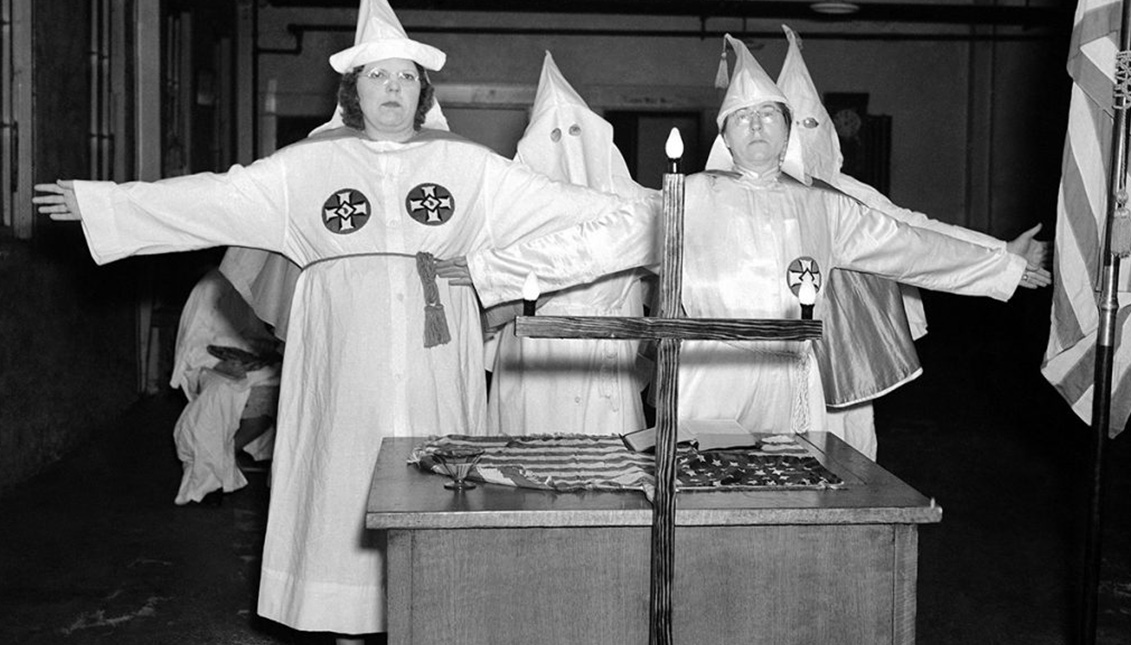
'Klanswomen,' when supremacism masqueraded as feminism
They advocated women's suffrage and an eight-hour workday, but beneath these claims by the Klanswomen lurked something sharper than the needle with which they…
They spoke to her "as if because of my color I had to go along with their insidiousness," said Kathleen Blee.
A professor of sociology at the University of Pittsburgh, Blee spent years traveling from one end of the United States to the other to bring to light a very thorny issue, the participation of women in the Ku Klux Klan, the racist organization that since the 1920s lynched and persecuted not only African Americans but Jews, Catholics, brown people, Asians, Mormons, socialists... and all those supposed enemies of the gospel.
This is one of the best "hooded" chapters of the Klan, which has to do with the participation of women who, according to Blee, were "the glue" of the organization and who officiated publicly by organizing parties and charity collections while acting as angelic decoys and activists for white women's suffrage. Their role, she says, was pivotal.
The discovery had come to this academic by surprise when she found a Klan pamphlet from the 1920s advocating women's suffrage and arguing, among other things, that women should not lose their maiden names on marriage and that an eight-hour working day for homemakers should be recognized.
From then on, Blee collected hundreds of stories and data, finally narrowing her search to the state of Indiana, where around a quarter of a million Klanswomen lived in the 1920s.
The result was the essay Women of the Klan: Racism and Gender in the 1920s, a harrowing treatise on the growing power of women in this racist watchtower, whose echoes are powerfully reminiscent of the assault on the Capitol on 6 January.
The role of women within the KKK was not always of equal importance. Originating after the Civil War (1861-65) out of dissatisfaction with the abolition of black slavery, the Klan consisted mostly of white men who for four years until 1871 committed all manner of crimes against African Americans and established slogans and rituals, while women sewed "uniforms" and acted as "angelic and innocent objects" to be protected from black men.
However, it was in 1915 when a Jewish pencil maker from Atlanta, Leo Frank, was accused of raping and murdering a young girl and lynched by an angry mob - Frank was innocent and was posthumously acquitted in 1986 - that the KKK renewed itself and expanded its list of enemies to include Jews, Catholics, Mormons, LGBTQ+ folks, and socialists — enemies, in short, of white Protestantism and nationalism.
Now the Klan hoods were less necessary. They had reinvented themselves and did not plan to hide, and also, in a way, broadened their language.
Someone had to make up for African-Americans having the right to vote, and they wanted to be the ones to do it.
In fact, writer and scholar of religion and racial hatred, Kelly J. Baker, told the NYT about the recent siege of the Capitol in January that religious fervor linked both the 6 January assailants and the KKK, as they saw themselves as part of a "holy war."
"(The KKK) were bankers and dentists and lawyers, pastors and politicians. They were white men and women. They explicitly stood for white supremacy and white Protestantism. It is arguably also an evangelical movement. To be a member, you had to be a white Christian. You had to support nationalism and patriotism. They actively encouraged their members to go to church. Their language was definitely influenced by evangelicalism, the way they talked about Jesus Christ as their Lord and Saviour," she said.
But after Frank's assassination, the role of the women in the Klan changed, and they took on greater power. The Women Ku Klux Klan, an organization twinned with the men's one, was created.
RELATED CONTENT

In her research on Klanswomen, Kathleen Blee had access to numerous survivors who reaffirmed, to her surprise, their anti-Semitic hatred, convinced that Blee's whiteness made her an ally - "the Jews are manipulating blacks as well as whites," they told her.
But what was most disturbing was how these women turned social activists and organizers of cultural and charitable events had emerged as great fighters for women's suffrage. Why? Someone, they explained, had to make up for the votes given to Blacks.
In these ways, social gatherings tinged with activism were, in reality, a sieve of racism and false accusations that spread through the community and served to justify lynchings and other criminal acts carried out by men.
Famous "suffragette-supremacists" such as Vivian Wheatcraft later joined the ranks of Republicanism.
A full-blown whitewash, it became influential beyond the South and, according to Blee, had a membership of up to around 6 million Americans who believed it to be a "social club."
It was promoted as a gathering to "have a good time" and share the American spirit. However, Klanswomen disparaged Jewish or white candidates over tea and pastries. And they were both well-to-do housewives and women seeking to move up the social ladder - women's suffrage had just been recognized in 1920. However, African-American women were not allowed to vote in some southern states until the 1960s.
Among the most prominent names of these "suffragettes" and "supremacists" are Vivian Wheatcraft and Lillian Sedwick, who continued their careers within Republicanism after the Klan disappeared in 1930; or Ann Carroll, who led the League of Women Voters and also ( though it may seem a contradiction) the League of White Supremacy in Indianapolis.
There is not one feminism, but many. Yet none of these worldviews can have a hatred of the other, persecution and violence exercised directly or indirectly as its foundation. Feminisms are dialogue and empathy and the struggle for equality from diversity.
Everything else is patriarchy in a wig.












LEAVE A COMMENT: